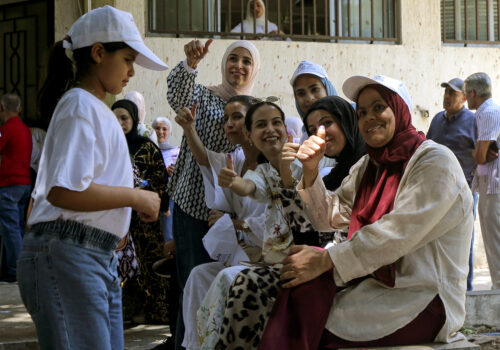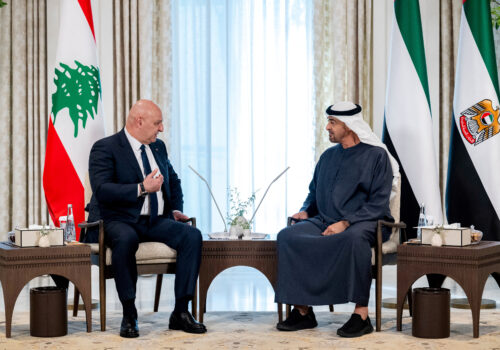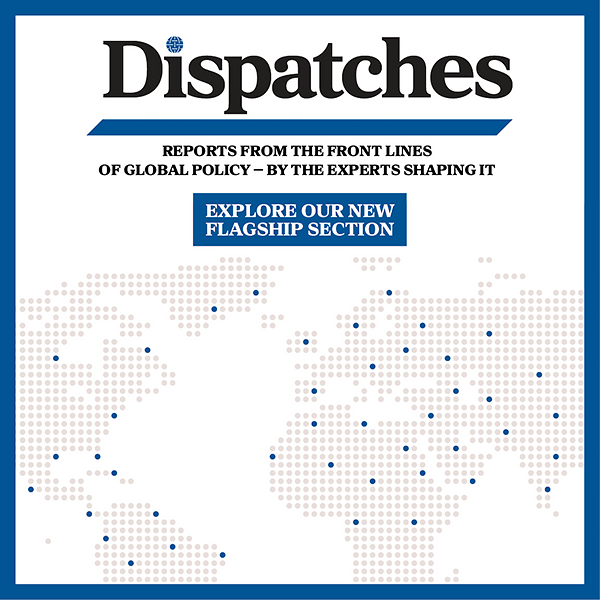What to know about the history (and future) of the Hezbollah disarmament question
The Lebanese government’s recent failure to pass a motion to disarm Hezbollah, despite announcing a timeframe for doing so, underscores how deeply embedded the debate over Hezbollah’s armed status has become in Lebanon’s political landscape.
Participants in that debate have been discussing the perceived legitimacy of Hezbollah’s role as an armed “resistance” movement against Israel and the political, security, and societal consequences of its continued possession of weapons outside state control.
That discussion—which has, for example, played out in heated exchanges in parliament following the motion’s introduction—illustrates the fragility of Lebanon’s confessional political system, in which power-sharing arrangements between sectarian groups require delicate compromises. This system rests on a tenuous consensus among political elites, one that is easily disrupted when contentious issues such as Hezbollah’s disarmament are raised.
This moment, however, still marks the opening of a new chapter, specifically Lebanon’s reckoning with armed pluralism. For the first time since the end of the civil war, the Lebanese state is considering a structured plan to address the parallel military power represented by Hezbollah.
Why Hezbollah is still armed
The 1989 Taif Accords, which ended Lebanon’s fifteen-year civil war, mandated the disbandment of all militias. However, Hezbollah was uniquely exempted under the justification that it was not a militia but a “resistance” movement against Israeli occupation in southern Lebanon. At the time, the Israel Defense Forces continued to occupy Lebanese territory, and the Lebanese state lacked the capacity to liberate the south on its own. With the backing of Syria and Iran, Hezbollah positioned itself as the vanguard of resistance. This exemption, both formal and informal, laid the foundation for Hezbollah to retain and expand its arsenal well beyond the 2000 Israeli withdrawal.
Three factors were central to Hezbollah’s exemption: the weakness of the Lebanese Armed Forces (LAF), the political cover provided by Syria’s dominance over Lebanon at the time, and the strategic utility that Hezbollah’s armed presence provided to Iran in its regional posture against Israel. Hezbollah thus became a hybrid actor: a political party, a military force, and a key Iranian proxy. The group’s legitimacy was further bolstered by its early successes against Israel and the 2006 war, which, despite massive destruction, was spun as a symbolic victory.
The political advantages it has gained
Hezbollah’s arms have enabled the group to tap a range of strategic, political, and social benefits.
Hezbollah emerged as the only actor in Lebanon perceived as capable of responding to Israeli actions. Hezbollah has consistently framed its armed wing as a deterrent force aimed at defending Lebanon from Israeli aggression. This narrative gained legitimacy during key episodes, such as the Israeli withdrawal from southern Lebanon in 2000 and the 2006 war with Israel. Hezbollah’s resilience during the 2006 war, despite the widespread destruction it invited, boosted its reputation among segments of the Lebanese and Arab populations as a legitimate resistance force.
SIGN UP FOR THIS WEEK IN THE MIDEAST NEWSLETTER
Second, Hezbollah’s arms gave the group political leverage. Hezbollah has repeatedly used the implicit threat of force to gain veto power in the government and influence over state decisions. Over time, Hezbollah’s use of arms expanded beyond this narrative. Domestically, Hezbollah employed its military force during internal political crises, most notably in May 2008 when it took control of West Beirut after the government moved to dismantle the group’s telecommunications network. This act was a turning point, showcasing Hezbollah’s readiness to use force not just against external enemies but also internally to maintain its political interests.
Regionally, Hezbollah became an expeditionary force, supporting Bashar al-Assad in Syria and training militias in Iraq and Yemen. This expanded its role beyond a local resistance group into a transnational actor aligned with Iran’s broader regional agenda. Domestically, Hezbollah’s military might enabled the group to build parallel institutions, including a security apparatus and a vast social welfare network, further entrenching its role in Shia-majority areas.
Public opinion and the erosion of legitimacy
In the early 2000s, Hezbollah enjoyed significant cross-sectarian support. The Israeli withdrawal from southern Lebanon in 2000 and Hezbollah’s performance in the 2006 war boosted the group’s national standing. However, that legitimacy has waned. Many in Lebanon, especially among the Sunni and Christian communities, now view Hezbollah’s arms as a threat to national unity and a hindrance to state sovereignty. The 2019–2020 protest movement, which spanned sectarian lines, included vocal criticism of Hezbollah and its role in preserving the corrupt political order. Moreover, Hezbollah’s involvement in Syria and its perceived prioritization of Iranian interests over Lebanese ones have alienated many.
Polling data and street mobilizations suggest that while Hezbollah maintains strong support among Shia Lebanese people, especially in the south and the Bekaa Valley, it faces increasing criticism from Sunnis, Christians, and Druze communities. The 2020 Beirut port explosion further deepened public frustration after local reports came out alleging that the explosion occurred at a weapons warehouse owned by Hezbollah (although Hezbollah’s leader denied these claims, as did Lebanon’s president). War fatigue, economic hardship, and political deadlock have all fed into calls for disarmament.
Thus, while Hezbollah’s military capacity once served as a symbol of national pride, today it is increasingly seen as a liability amid economic collapse and demands for sovereignty.
Rising pressures for disarmament
Calls for disarmament gained urgency with the confluence of mounting internal and external pressures that have reshaped the political landscape in Lebanon.
Foremost among these is the country’s devastating economic collapse, which has not only plunged millions into poverty but has also provided powerful external actors, particularly Western countries and Gulf states, with newfound leverage. These states have increasingly tied economic assistance and reconstruction aid to the implementation of meaningful reforms, chief among them the disarmament of Hezbollah and the reassertion of state sovereignty.
Simultaneously, regional shifts have weakened the logistical and strategic networks that once sustained Hezbollah’s military strength. The Assad regime’s declining capacity to serve as a reliable conduit for arms and Iranian economic distress have together eroded the group’s ability to replenish its arsenal and maintain operational readiness.
This vulnerability was starkly exposed during the 2024 war with Israel. Set in motion by a chain of events (starting with Hamas’s October 7, 2023 attack), Israel’s large-scale assault on Hezbollah in September and October 2024 eventually resulted in the killing of most of Hezbollah’s senior military commanders and much of its political leadership, including its long-revered secretary general, Hassan Nasrallah. During the campaign, Israel also destroyed a significant portion of the group’s rocket and missile arsenal. Hezbollah also saw widespread damage done to key infrastructure and heavy attrition among its fighters. These military setbacks have challenged Hezbollah’s deterrent posture and emboldened critics both within Lebanon and abroad.
Furthermore, international diplomacy has introduced new constraints: The US-brokered cease-fire that ended the recent hostilities imposed terms—stricter than those of UN Security Council Resolution 1701, adopted to end the 2006 Lebanon War—calling explicitly for the disarmament of all nonstate actors, particularly south of the Litani River. In the aftermath of Hezbollah’s severe military and political weakening, the United States, France, and other international actors have leveraged this moment to press the Lebanese government more forcefully to move ahead with disarmament efforts. These international actors have coupled their demands with calls for sweeping economic reforms, presenting the fulfilment of these demands as a prerequisite for unlocking much-needed international financial assistance.
Together, domestic opposition and international demands have brought the question of Hezbollah’s arms to the fore, placing the group in an increasingly precarious position.
Hezbollah’s dilemma
Disarmament would force Hezbollah to reconfigure its identity and operational model. It would lose the coercive leverage it currently enjoys in political negotiations. Although the group retains a formidable political organization, including seats in parliament and strong alliances, operating solely as a political party would limit its ability to dominate the Lebanese system.
Within the group, disarmament poses risks to Hezbollah’s cohesion. Its military wing has a distinct culture and structure that may resist integration into the LAF or disbandment. Splinter groups could form, and fighters could turn to criminal or radical networks. Hardliners within Hezbollah may interpret disarmament as capitulation, potentially leading to internal rifts.
What comes next
Looking ahead, a range of potential scenarios could unfold depending on how the disarmament of Hezbollah is implemented.
One possible scenario is that, following a negotiated integration process in which Hezbollah agrees to gradually relinquish its arsenal in exchange for political guarantees and security assurances for Lebanon’s Shia community, some of its fighters become absorbed into the LAF. Others would transition back into civilian life through reintegration programs. To achieve this scenario, international actors, particularly the United States, France, and key Gulf states, could help facilitate the disarmament process by providing mediation, security guarantees, and technical assistance for disarmament verification. International donors could also condition economic aid on progress toward integration, ensuring incentives for all parties to remain committed.
Another possibility is that Hezbollah engages in partial and clandestine disarmament, relinquishing its overt military presence while secretly retaining a covert arsenal or sleeper networks as a form of deterrence. This would mirror patterns observed in other post-conflict societies in which militias officially disarm but preserve underground capabilities.
A third scenario involves a continued political stalemate. This would take place in the event of prolonged negotiations, the selective enforcement of cease-fire provisions, and an absence of enforceable timelines or verification mechanisms. In this case, the Lebanese government proves unable or unwilling to implement disarmament, resulting in a status quo of dual authority that perpetuates institutional paralysis and undermines state legitimacy. Given Lebanon’s deeply divided sectarian political system, the vested interests of political elites in preserving the current balance of power, and Hezbollah’s entrenched influence within state institutions, this scenario is the most likely outcome. The lack of political consensus, combined with the absence of credible enforcement capacity, makes incremental or symbolic measures far more probable than full-scale disarmament.
A fourth scenario—the most destabilizing one—is one of confrontation and collapse, in which efforts to forcibly disarm Hezbollah provoke armed resistance, potentially igniting internal conflict or even plunging Lebanon into civil war.
Each of these scenarios entails significant risks. Successful integration and reintegration would require robust infrastructure, institutional readiness, and the political will to support a peaceful transition. Conversely, failure to manage this process effectively could result in further fragmentation, instability, and violence, particularly in regions traditionally under Hezbollah’s control. But international actors can help tilt the balance toward the more positive scenarios by combining diplomatic pressure with tangible economic incentives, ensuring that progress on disarmament is directly linked to Lebanon’s recovery and stability.
The future of Hezbollah’s arms, and by extension, Lebanon’s political trajectory, will hinge on whether domestic actors and international stakeholders can seize this moment of unprecedented vulnerability to negotiate a sustainable settlement. Success could redefine Lebanon’s statehood in the twenty-first century. Failure would not simply preserve the status quo but instead risk locking the country into a prolonged cycle of paralysis, dependency, and decline.
Kristian Patrick Alexander is a senior fellow and lead researcher at the Rabdan Security and Defense Institute.
Further reading
Tue, Jun 17, 2025
Why Hezbollah is unlikely to engage in the Israel-Iran war—for now
MENASource By David Daoud
As wave after wave of Israeli jets continue to strike Iran, Tehran's proxy on Israel’s northern border remains quiet.
Wed, Jun 4, 2025
What Lebanon’s municipal election results mean for Hezbollah
MENASource By David Daoud
Municipal election results did not demonstrate the militant group’s dominance over Lebanon’s Shiites, but Hezbollah nevertheless retains popularity.
Mon, May 12, 2025
Landmark UAE visit highlights President Aoun’s catch twenty-two
MENASource By Jean-Loup Samaan
Modest outcomes from the Lebanese president's visit reflects that Abu Dhabi remains cautious towards Beirut.
Image: Supporters of Lebanon's Hezbollah militant group rally in cars and motorbikes to protest the government's endorsement of a plan to disarm it in Beirut's southern suburbs on August 8, 2025. Photo by Fadel Itani/NurPhoto via Reuters.



